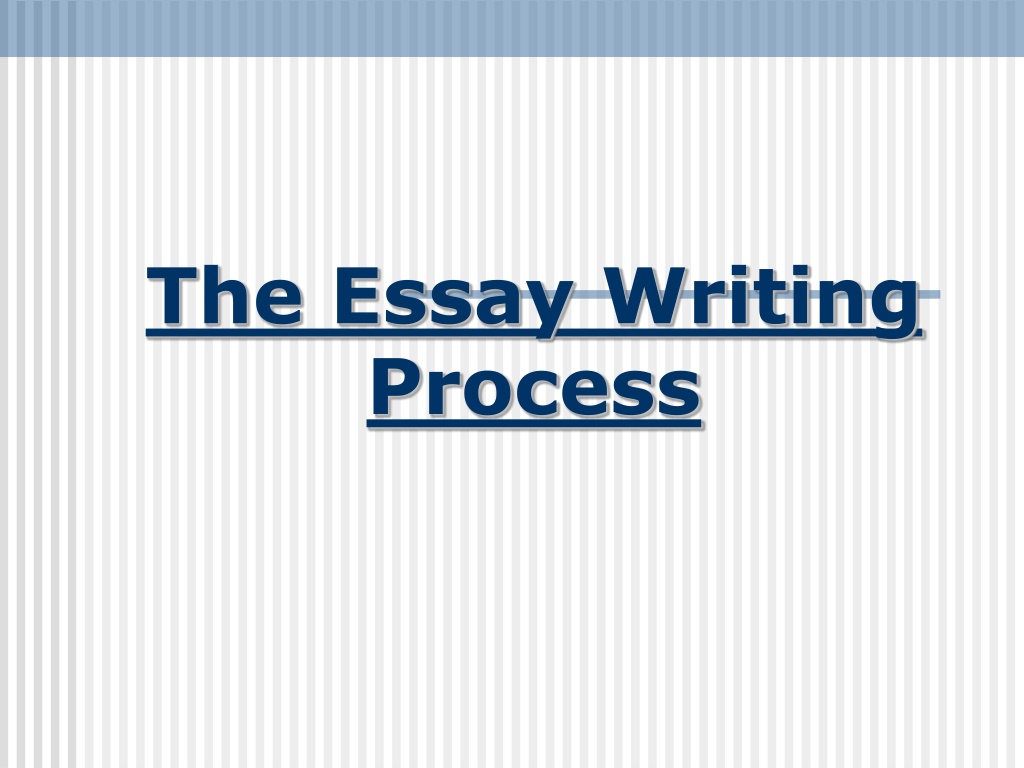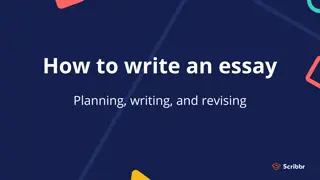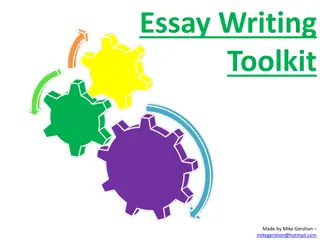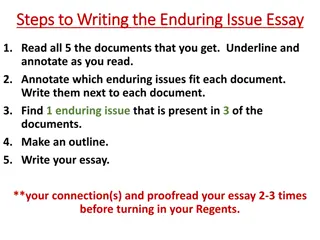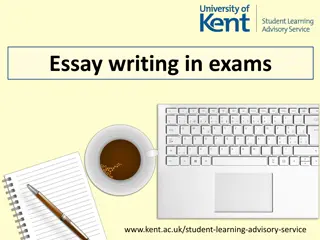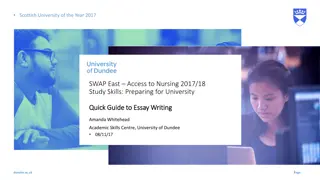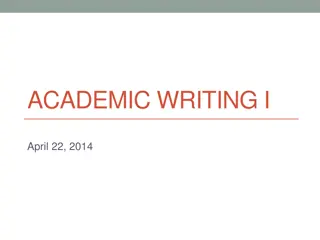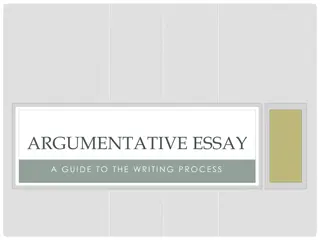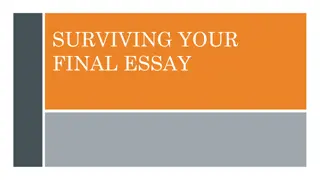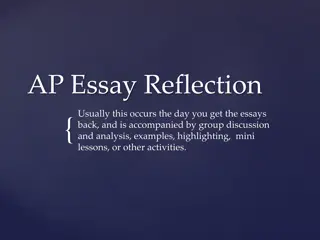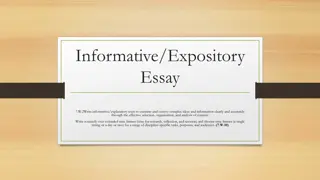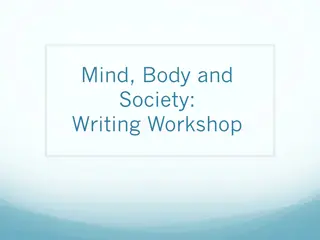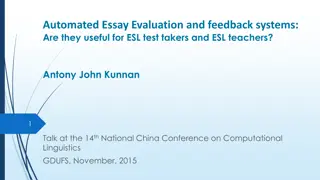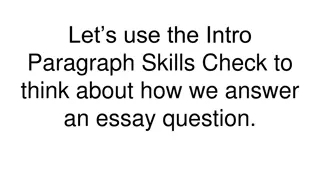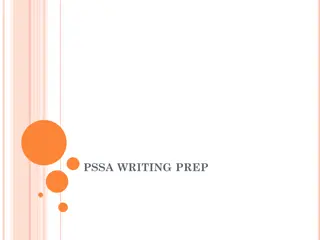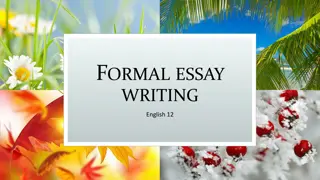The Essay Writing Process
The essay writing process is a recursive and iterative method that involves composing different parts such as introduction, body paragraphs, and conclusion. This process is illustrated through diagrams and integrated with blogging to enhance the writing experience. Understanding the parts of an essay, the overview of an essay, and the hamburger method are key aspects covered in this informative content.
Download Presentation

Please find below an Image/Link to download the presentation.
The content on the website is provided AS IS for your information and personal use only. It may not be sold, licensed, or shared on other websites without obtaining consent from the author.If you encounter any issues during the download, it is possible that the publisher has removed the file from their server.
You are allowed to download the files provided on this website for personal or commercial use, subject to the condition that they are used lawfully. All files are the property of their respective owners.
The content on the website is provided AS IS for your information and personal use only. It may not be sold, licensed, or shared on other websites without obtaining consent from the author.
E N D
Presentation Transcript
The Essay Writing Process
A Recursive Process Writing is also a recursive process. This means that you repeat the steps over and over again, though not necessarily every step, every time.
The following diagram illustrates the recursive nature of the writing process.
Blogging the Writing Process: An Introduction: Blogging proved to be an effective tool for the writing process evidenced by the numerous benefits for its use that outweighed the drawbacks. Throughout this course, blogging will be integrated into the five stages of the writing process in different types of essays. approach as order to compose
As shown in the diagram below, blogging will be integrated into the five stages of the writing process approach which; in turn, will be broken down to a number of key stages:
Parts of an Essay Conclusion Introduction Body Paragraphs
Introduction What is an essay ? An essay is a piece of writing that usually has five or more paragraphs. An essay is written about one topic that has several main points. The main points are introduced in an introductory paragraph and supported in body paragraphs. The conclusion is the last paragraph. Essay Body Paragraph 3 Introduction _____________ _____________ Conclusion Body Paragraph 1 _____________ _____________ Body Paragraph 2 _____________
Overview of an Essay Introduction General statements and information about the topic Body Thesis statement- lists the main ideas in the essay Paragraph 1 Body Paragraphs Body Support the main ideas of the thesis statement Paragraph 2 Body Begin with topic sentences Paragraph 3 Conclusion Brief summary of main points of the essay
The Hamburger Method Essays, like sandwiches or burgers, are divided into different parts. Introduction Body Conclusion
Parts of an Essay An Introduction An introductory paragraph is the first paragraph in an essay. It contains two parts. 1. General Statements: a few sentences about your subject that catch the attention of your reader. 2. A Thesis Statement: one sentence that tells your reader the main points of your topic and states the overall plan of your essay.
Parts of an Essay Body Paragraphs The body consists of one or more paragraphs following the introduction. Each paragraph supports the main idea of your essay by breaking it down into smaller ideas or sub- topics. Each body paragraph consists of a topic sentence and several supporting sentences. A conclusion sentence draws the paragraph together. Body Body Body Introduction Paragraph 1 Paragraph 2 Paragraph 3
Parts of an Essay Conclusion The conclusion paragraph is the last paragraph in the essay. It completes the essay by summarizing or repeating the most important ideas. The conclusion can also include an opinion, a prediction, or a solution to a problem. Introduction Body Paragraph 1 Body Paragraph 2 Body Paragraph 3 Conclusion
Example An Introduction General Statements Going to a new school can be exciting, but for an international student, the years of education in a different country can be difficult and tumultuous. When I first arrived in the U.S. to attend a university, I was overwhelmed and confused by everything new. Fortunately, I met three very special friends who made a positive impact on my life during those years and helped me survive the trials of being a foreigner in a completely different educational system. Thesis Statement
Example Body Paragraph Topic Sentence One of the first people I met was Joe Frieda. I first met Joe standing in a line at the bookstore. I was having a difficult time finding the books for the English classes I was taking my first semester here. He not only helped me find my books, but he also gave me some good advice on where to get tutorial help on campus and where I could find some good restaurants. We ve become better friends since then and he has been so helpful in answering any questions I have about going to school in the U.S. and about American culture. If I hadn t met Joe that day, I might still be looking for the right books for my classes! Concluding Sentence Supporting Sentences
Example Conclusion Summary of Main Ideas The significance of the kindness that these three people showed me and the impact that it has made on my life during my experience as an international student at State University cannot be underestimated. I will never forget their friendship and will remember their examples of kindness to me whenever I encounter other foreigners in my own country. Promise or Resolution
Stages of the Writing Process
1)Prewriting Prewriting is the first stage of the writing process. Prewriting, as its name suggests, is something you do before you write a paragraph or essay or other written work. The purpose of the prewriting stage is to find a topic for writing, to collect ideas and information, and necessary. There are many different types of prewriting that help writers generate ideas. The different types of prewriting that we will explore here are: freewriting, brainstorming, clustering, questioning, and Venn diagram. to do research if
A)Freewriting Freewriting is when someone writes freely what comes to mind in sentences or phrases, without worrying about grammar, punctuation or making sense.
B)Brainstorming Brainstorming or listing is when you freely write down all ideas in the order which they occur to you.
C) Questioning When you prewrite with the questioning technique, you are trying to find out the How? Who? When? and Why? about your topic. What? Where?
D) Clustering Clustering, or mind mapping is a "visual of outlining", putting the main topic in the center of paper and lining it with any new ideas associated. You can also group sub- ideas around this new idea. This strategy allows you to collect ideas effectively and, particularly, understand the logic contained between ideas.
E) Venn diagram A Venn diagram is used to help visualize the similarities and differences between two subjects. Venn diagrams are very useful when brainstorming a compare and contrast essay.
2)Drafting Drafting is the second stage of the writing process. At this stage, the writer should write a complete first draft using his or her notes from prewriting as a guide. The purpose in drafting is to have a complete draft, not a perfect one, so writers are encouraged to ignore spelling or grammar mistakes and write quickly
3)Revising Revising the writing process In fact, to revise means literally to re-see or re-look at your writing. When you revise, you look at the parts of your essay and make sure that each part works together to make a coherent whole. Similarly, feedback from others can help you identify those parts of the essay that work well--and those that do not. Revising often cutting, moving, or changing information in order to make the ideas clearer, more accurate, more interesting, convincing. is the third stage of includes adding, or more
4)Editing Editing is the writing process. In this stage, you check your text to make sure that there are no errors in grammar, punctuation, and spelling. fourth stage of the
5) Publishing This is the last stage of the writing process. In this stage, you share the essay you have written with the readers you determined in the prewriting stage.The publishing is to share and celebrate your finished products. When writers publish their writing, they produce a clean, neat final draft thatis free of errors. purpose of
